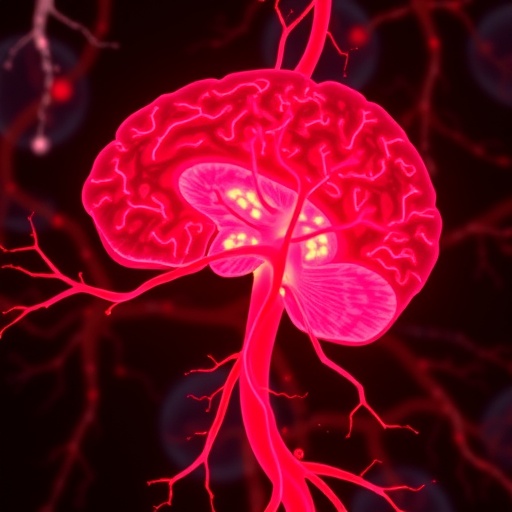Recent research has unveiled a fascinating aspect of metabolism that diverges based on sex, attributing this phenomenon to specific neurons within the hypothalamus. The study in question, led by researchers Cabral-da-Silva, Zanesco, and Valdivieso-Rivera, provides compelling insights into the relationship between metabolic processes and sexual dimorphism, particularly through the lens of Fezf1 neuron-specific brain-derived neurotrophic factor (BDNF) knockout models. This groundbreaking work is positioned at the nexus of neurobiology and metabolic research, shedding light on the complex interplay between the brain and body in regulating metabolism.
At its core, metabolic sexual dimorphism refers to the distinct differences observable in metabolic processes between male and female organisms. This divergence has been a subject of intense investigation, as understanding the underlying causes can lead to significant advancements in personalized healthcare strategies. By focusing on the hypothalamus and the Fezf1 neurons—which play a central role in bodily homeostasis—this study aims to unveil the molecular and cellular mechanisms that contribute to these sexual differences in metabolism.
Utilizing sophisticated genetic manipulation techniques, the researchers specifically knocked out the BDNF gene in Fezf1 neurons. BDNF is known for its crucial role in neuronal survival, growth, and differentiation, as well as its involvement in metabolic function. The decision to focus on BDNF originated from its previously demonstrated influence on food intake, energy expenditure, and overall metabolic balance, thus providing a useful framework for studying sexual dimorphism.
The effects of the BDNF knockout were assessed using a variety of metabolic assays designed to measure parameters such as glucose homeostasis, insulin sensitivity, and energy expenditure. Intriguingly, the study observed a remarkable difference in outcomes based on sex. Male and female subjects responded differently to the absence of BDNF, which highlighted the inherent biological distinctions in their metabolic pathways. These findings resonate with earlier theories suggesting that sex hormones could modulate the expression of metabolic genes, thus influencing the overall metabolic phenotype.
The study pushed the boundaries of understanding by incorporating high-dimensional methodological approaches, such as transcriptomic and proteomic analyses. This enabled the researchers to profile changes in gene and protein expression associated with the BDNF knockout in Fezf1 neurons. The detailed biochemical alterations observed in male and female models underscored a sexually dimorphic response at the cellular level, affirming the hypothesis that the nervous system plays a pivotal role in modulating metabolic functions.
One exciting implication of this research is the potential it holds for addressing obesity and metabolic disorders that manifest differently across sexes. By dissecting how and why these differences arise, researchers could inform targeted interventions and therapeutic strategies that consider the unique metabolic profiles of males and females. Given the prevalence of obesity-related diseases and the growing recognition of sex as a biological variable, such insights are invaluable.
Moreover, the implications extend beyond just metabolic health. The findings could have repercussions for understanding neurological conditions, given that BDNF is also implicated in various neurodegenerative diseases and mental health disorders. Insights into the sexual dimorphism in metabolic functions may, therefore, contribute not only to improving metabolic health but also to addressing related neurological conditions.
Furthermore, the complexity of hormonal influence on metabolism cannot be overstated. Sex hormones such as estrogen and testosterone play a foundational role in regulating various pathways in the body. This characterization of metabolic sexual dimorphism may encourage further exploration of the interaction between these hormones and the neurobiological factors contributing to metabolic regulation.
As society grapples with rising rates of metabolic disorders, these findings invite a re-examination of treatment modalities for obesity and associated conditions. Rather than a one-size-fits-all approach, there may be merit in developing sex-specific therapies that acknowledge the biological and genetic differences highlighted by this study. In doing so, the pursuit of improved health outcomes could become more targeted and effective, aligning treatment with the nuanced realities of male and female physiology.
This research also raises pertinent questions about the future of metabolic studies and their intersection with personalized medicine. As the capability to conduct extensive genetic and molecular profiling increases, the potential to understand individual metabolic responses based on genetic makeup and sex becomes more feasible. The rich data set generated by this research serves as a precursor to much larger studies aimed at understanding the diverse landscape of metabolism in human populations.
In conclusion, the work spearheaded by Cabral-da-Silva and colleagues signifies a watershed moment in the field of metabolic research. By highlighting the role of Fezf1 neuron-specific BDNF knockout in elucidating metabolic sexual dimorphism, the study opens new avenues for understanding how male and female bodies may require different approaches to health and disease management. The intricate dance between our brains and bodies, orchestrated through a medley of genes and hormones, continues to reveal its depths, with implications that could shape the future of healthcare.
The future of metabolic research looks promising, with the potential for breakthroughs that could transform our understanding of health disparities based on sex and enhance therapy options tailored to individual physiological needs. This study serves as a critical step forward in recognizing and addressing the complexities that shape our metabolic health, inviting further exploration into the remarkable aspects of sexual dimorphism.
By paving the way for additional inquiry, investigations like this can foster a deeper comprehension of how we can leverage the nuances of biological sex to inform better, more effective medical practices, ultimately leading to a healthier society.
Subject of Research: Metabolic sexual dimorphism associated with hypothalamic Fezf1 neuron-specific BDNF knockout.
Article Title: Metabolic sexual dimorphism in hypothalamic Fezf1 neuron-specific BDNF knockout.
Article References:
Cabral-da-Silva, D., Zanesco, A.M., Valdivieso-Rivera, F. et al. Metabolic sexual dimorphism in hypothalamic Fezf1 neuron-specific BDNF knockout.
Biol Sex Differ 16, 95 (2025). https://doi.org/10.1186/s13293-025-00770-z
Image Credits: AI Generated
DOI: https://doi.org/10.1186/s13293-025-00770-z
Keywords: Metabolic sexual dimorphism, hypothalamus, Fezf1 neurons, BDNF knockout, neurobiology, metabolism, obesity, sex hormones, personalized medicine.




